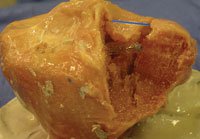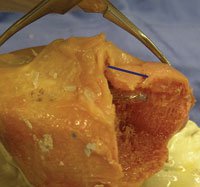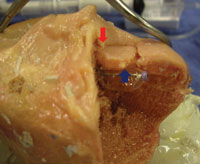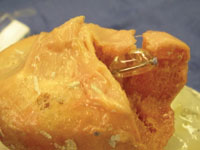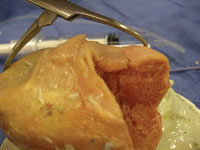How to avoid the ‘trap door’ effect in reducing tibial plateau fractures
The split-depression lateral plateau fracture is a common fracture pattern. Usually, the fracture is approached laterally, the split reduced with a bone clamp, the articular depression reduced through a cortical window and the fragment maintained in place with bone graft or bone graft substitute. Actually, this sequence may make perfect reduction impossible because the space for the articular fragment is too narrow. This is the “trap door” effect. In this technique tip, we recommend reducing the depression prior to clamping the split fragment.
Fracture reduction
Internal fixation of displaced tibial plateau fractures can be difficult even for the most experienced orthopedic surgeons. Techniques include multiple large incisions with anatomic plates, newer lesser invasive plating systems or even hybrid type external fixation.
The lateral split-depression type fracture is one of the most common types of tibial plateau fractures encountered. One must reduce and stabilize the lateral plateau to maintain overall alignment and joint stability (Berkson et al; Lansinger et al), while at the same time attempt to restore the congruity of the articular surface.
When performing internal fixation of split-depression type tibial plateau fractures, the depressed fragment must be elevated and the resulting void filled for support. Reduction can be verified by using imaging alone, but is better visualized with either arthroscopy or direct visualization via a sub-meniscal arthrotomy. With a severely displaced lateral fragment, the joint surface can often be approached through the split fracture and elevated under direct visualization. However, if the fragment is minimally displaced, attempts are made to avoid further disruption of the fracture to gain access to the depressed articular fragment. In these instances, the lateral fragment is often reduced with a periarticular clamp and held secured while the joint surface is elevated through a separate cortical window (Koval et al). The fragments are temporarily stabilized, the void filled and final fixation is then applied.
We have recently performed extensive lab testing on cadavers using an inflatable bone tamp (Kyphon; Sunnyvale, Calif.) to reduce depressed articular fractures. We report now a potential hindrance to the reduction of the articular surface that we have termed, the “trap door” effect.
Clamp the lateral fragment
When a split depression fracture of the lateral tibial plateau is encountered, the depressed fragment has a specific anatomic space available for reduction (Figure 1). One commonly used method of obtaining reduction is to clamp the large fragment in its reduced position first and then to elevate the depression. This can, however, hinder the elevation of the joint surface by closing down the available space for reduction (Figure 2).
|
|
Images: Mauffrey C |
Whether using the inflatable tamp or a conventional metal tamp, if this space is closed, the piece cannot be completely elevated, preventing congruent reduction of the articular surface (Figure 3).
By loosening the clamp or applying it after the articular reduction, this space is maintained allowing anatomic restoration of the joint surface (Figure 4).
|
|
|
The clamp can then be applied securing the lateral fragment (Figure 5). The void is then filled and fixation applied in a customary fashion.
Restoration steps
Restoring articular congruity after tibial plateau fractures can be difficult and acceptable limitations vary from 2 mm of residual step-off to greater than 1 cm of step-off (Burri et al; Weigel et al).
|
|
Restoring mechanical alignment and joint stability are the primary goals (Lansinger et al), and this is often less difficult to address. Even though satisfactory outcomes have been reported with large residual articular step-offs (Burri et al), an anatomic reduction is always preferred.
Many techniques are available to elevate depressed articular fragments including metallic tamps and elevators, and more recently, inflatable bone tamps. Regardless of the method chosen to perform reduction, the anatomic space for the fracture fragment must be present to enable adequate reduction. Premature application of periarticular clamps can create the “trap door” effect, where this space is closed down and the depressed fragment cannot be completely restored to its anatomic location. It is our hope this subtle finding may help treating surgeons in providing better restoration of the articular surface in these often difficult fracture patterns. The concept can potentially be applied to depressed articular fractures of any joint.
References:
- Berkson E, Virkus W. High-energy tibial plateau fractures. J Am Acad Ortho Surg. 2006;14(1):20-31.
- Browner B, Jupiter J, Levine A, et al. Skeletal Trauma. 4th ed. Philadelphia: Elsevier Inc.; 2009.
- Burri C, Bartzke G, Coldewey J, Muggler E. Fractures of the tibial plateau. Clin Orthop Relat Res. 1979;138:84-93.
- Koval K, Helfet D. Tibial plateau fractures: evaluation and treatment. J Am Acad Ortho Surg. 1995;3:86-94.
- Lansinger O, Begman B, Korner L, Andersson GB. Tibial condylar fractures: A twenty-year follow-up. J Bone Joint Surg Am. 1986;68:13-19.
- Weigel DP, Marsh JL. High-energy fractures of the tibial plateau: Knee function after longer follow-up. J Bone Joint Surg Am. 2002;84:1541-1551.

- Brandon Broome, MD, can be reached at the Department of Orthopedic Surgery, University of Louisville, 210 E. Gray St., Suite 1003, Louisville, KY 40202; 502-852-5319; email: broome.brandon@gmail.com.
- Cyril Mauffrey, MD, FRCS, is a trauma fellow at University of Louisville Hospital. He can be reached at 502-712-9819; email: cmauffrey@yahoo.com.
- David Seligson, MD, is Professor, Chief of Orthopedic Surgery, University of Louisville Hospital. He can be reached at 210 E. Gray St., Suite 1003, Louisville, KY 40202; 502-852-0923; email: seligson@louisville.edu.
- Jeremy Statton, MD, is Assistant Professor, Department of Orthopedic Surgery, University of Louisville. He can reached at 4001 Kresge Way #132, Louisville, KY 40207; 502-896-0190; email: jostatton@gmail.com.
- Disclosures: Broome, Mauffrey, Statton and Seligson have no relevant financial disclosures.

